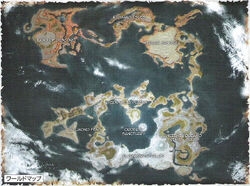
World Map in Final Fantasy IX.
The World Map (ワールドマップ, Wārudo Mappu?), also known as the Overworld, plays a prominent role in many games of the Final Fantasy series. It is a smaller-scale representation that is used in the game to make travel less time-consuming and easier for the player. On it, the player can move about between various locations including towns, dungeons, and other areas, as well as fight monsters in random encounters. Later games, including Final Fantasy X, Final Fantasy XI, Final Fantasy XII, and Final Fantasy XIII, did away with an explorable World Map and replaced it with groups of large, fully-scaled, interconnected areas.
The game offers various modes of transportation to the player. In most games, the player is initially forced to walk to each location. But, more modes of transportation become available as the game progresses and the player is required to overcome geological obstacles. These modes include boats, airships, hovercrafts, chocobos, etc.
The game's main theme, if not a variation of it, is usually played whenever the players travels around the World Map, with the exception being Final Fantasy VIII. Certain games in the series, especially Final Fantasy IV, have more than one overworld theme, because there is more than one overworld map.
Appearances
Final Fantasy
Template:Sideicon

Final Fantasy World Map.
In Final Fantasy, the world had a single map made up of three continents. The world's geography included forests, mountains, deserts, and a volcano. The player could use a boat to travel by sea, a canoe to travel by river, and an airship to travel anywhere with a clearing available. Points of interest in this world are the Chaos Shrine, Cornelia, Cavern of Ice, Crescent Lake, Mount Gulg and the Citadel of Trials.
Template:Gallery
Final Fantasy II
Template:Sideicon
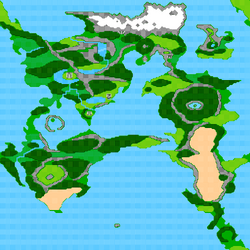
Final Fantasy II World Map.
Like the original, Final Fantasy II only had one map. It is unique in the series in that it is connected all around the world as one giant land mass. Most of the map can be accessed from the start, but strong enemies usually appear if the player strays too far from the path they are meant to take. Many areas are also inaccessible, and the party will not be able to enter them from the world map until later in the story. Mysidia and the Cave of Mysidia can be theoretically accessed from the start of the story; however, in the case of the latter, most of the area is inaccessible due to a Doppelganger blocking the path.
Notable locations include Fynn, Altair, Palamecia Castle and Pandaemonium. A Snowfield takes up a large portion of the north area of the map.
The world map is accessible only through the Ring key item, and by pressing B+Select together on the overworld in the NES version.
Template:Gallery
Final Fantasy III
Template:Sideicon Template:See Also Final Fantasy III was the first game to have several maps. The party starts off on a floating continent but later find that their "continent" is nothing but a small island levitating above the face of a huge world. This surface world also goes through some changes throughout the game's course. When first discovered, the world has been flooded as a result of the Water Crystal being taken over by Xande, leaving only a few patches of land accessible to the player. Later, the waters recede, revealing three large continents.
Template:Gallery
Final Fantasy IV
Template:Sideicon Final Fantasy IV has three world maps: the Overworld, the Underworld, and the Red Moon; however the Moon and Underworld are relatively small for world maps. The Overworld is the largest of the three and the place where the majority of the game takes place. It consists of oceans, mountains, plains, and forests and contains a number of towns, castles, and other accessible areas.
The Underworld is the second world map visited in the game and is cave-like. Its terrain consists of lava and caves with a few towns and castles, as well as the ground entrance to the Tower of Babel. The Underworld is unique in that one cannot cross from one side of the map to another by repeatedly going in the same direction. The Moon is the third and final world map in Final Fantasy IV and is made up of a few caves and the Crystal Palace. The terrain of the Moon is plain, consisting of caves and craters. It is the smallest of the game's world maps, and for that matter, the smallest of any world map.
While moving on the world map, if the player presses the Template:Nintendo X button very quickly, the player can enter the menu while the character is mid-transition. If the player then uses a Tent, the game's collision detection is off by a tile by the time normal gameplay resumes. With this the player can trigger a bypass event glitch.
Template:Gallery
Final Fantasy IV: The After Years
Template:Sideicon Template:Sec-stub
Final Fantasy V
Template:Sideicon Template:See Also Final Fantasy V had three world maps: Bartz's World, Galuf's World, and both of these worlds combined, the Merged World. The game adds two additional theoretical World Maps. There is an underwater map for Galuf's World which is used to sneak into the Barrier Tower. There is also an underwater map for the Merged World. The submarine opens up many optional places to be visited, such as the Sunken Tower.
Another quasi-World Map appears when the player allows Cid and Mid to upgrade the airship using Adamantite. This gives the airship the opportunity to fly at higher altitudes which allows the player to battle the Catapult. Once the Catapult quest is completed, the player can no longer reach those high altitudes.
Template:Gallery
Final Fantasy VI
Template:Sideicon Final Fantasy VI had two World Maps: The World of Balance and the World of Ruin. The game begins in the World of Balance, and after Kefka Palazzo changes the positions of the Warring Triad, the world changes to the World of Ruin. Traveling options include airship, ferries and chocobos, which can be rented from stables in towns and forests.
Template:Gallery
Final Fantasy VII
Template:Sideicon
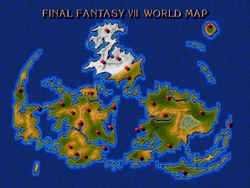
The Planet overworld.
Final Fantasy VII has three World Map modules, and it was the first to be rendered in full 3D. The World Maps in Final Fantasy VII are also the first World Maps with a controllable camera.
The primary World Map is the overworld. Although the overworld map remains the same throughout the game, there are a few changes at different points in the story, including the appearance of Meteor in the sky, and geographical changes. Some are just aesthetic such as the Temple of the Ancients and Mideel changing objects to reflect the changes in the field locations, while others change both aesthetics and functionality, including the addition of a crater in the Junon Area which renders Junon inaccessible by foot.
Most of the overworld is in daylight, but the area around Midgar and North Crater are always night, and the area around Cosmo Canyon is always dusk. The player can travel the map by buggy and Tiny Bronco before the summoning of meteor and by airship once meteor has been summoned. Chocobos can be captured and used for transportation even across otherwise unreachable terrain.
The second World Map is the Bottom of the Sea map accessible with the Shinra Sub. Like underwater World Maps of previous games, the player can freely enter and leave it by surfacing and submerging the submarine. Only an area at the center of the World Map between the main three continents can be accessed, although there are numerous tunnels that travel underneath the continent. One of these tunnels leads to a location called ???, normally only accessible through certain breeds of chocobo. The map display used is the same as the overworld map. There are no random encounters, but the player can face the Emerald Weapon in a fixed encounter here.
The third World Map isn't technically a World Map; however, it is a World Map module within the game. In the Great Glacier is an area where the player is seen from a top-down view, and they can move the camera. While traversing this area, snowstorms occur, changing the camera angle. To navigate the area, the player can leave flags, so when the camera angle is changed, they can follow in the same direction. The player can exit into different areas by moving off the edge of the map, but there is still one area in the middle, a cave containing an All Materia. The World Map connects the rest of the Great Glacier to the base of Gaea's Cliff. There are random encounters.
Final Fantasy VIII
Template:Sideicon
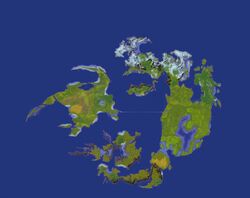
Final Fantasy VIII World Map.
Template:See Also Final Fantasy VIII again had just one World Map but had 32 locations to be explored. It was the first and only map to date to feature an optional 3D globe in place of the traditional map. While traveling on foot, the player can use the roads on the World Map to avoid random encounters. Other ways to travel the map are by rental car, chocobo, train, Balamb Garden, or airship.
The area around Deling City is always night, and around Dollet, it is always dusk. During the Lunatic Pandora event, the area near and around Tears' Point is enveloped in an ominous red aura with the Lunatic Pandora itself seen hovering over the point. The artificial sea-haven for artisans, Fishermans Horizon, is located in the center of the map's main ocean, and a causeway rail bridge spanning either direction from the town connecting Galbadia to Esthar, bifurcates the body of water making early transportation with Balamb Garden difficult.
During the Time Compression, most of the World Map locations become inaccessible and various "warp points" appear across the world for the player to travel in and out of Ultimecia Castle, where the titular Sorceress that initiated Time Compression resides.
Final Fantasy IX
Template:Sideicon
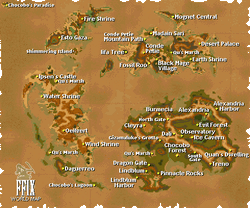
Gaia overworld map.
Template:See Also
Final Fantasy IX has two World Maps. At first, players are only granted a map of the known civilized world: the Mist Continent. After certain conditions are met, players receive an ancient map detailing all of Gaia, which is an expansion of the first map. The player can travel the map by chocobo, boat, or airship. Gaia is comprised of four major landmasses and their surrounding islands: the Mist Continent to the southeast, the Outer Continent to the northeast, the Lost Continent in the northwest, and the Forgotten Continent in the southwest.
An endless night shrouds the Dark City Treno, and rain falls upon the city of Burmecia, while the greatest landmass of the Forgotten Continent is forever locked in twilight (though the vast archipelago in its southern region remains sunny). The overall lucidity of the skies varies in the presence of Mist. Being a product of the Iifa Tree and its roots, this Mist only permeates the Mist Continent and around the tree itself on the secluded western half of the Outer Continent.
During the final events of Disc 4, similar to the endgame structure of Final Fantasy VIII, many locales become inaccessible (likely because of disc capacity concerns); they are sealed off with the Iifa Tree's roots, and the world becomes enveloped in Mist. The World Map is similar to the original Final Fantasy's World Map.
Chocobo footprints on the World Map let the player summon Choco by the use of Gysahl Greens. Secret chocobo treasures can be found from bubbling areas on the sea, and cracks in the mountains. Small circular shadows denote the location of Chocobo's Air Garden, and using a Dead Pepper on a flying Choco in these locations allows the player access to the final Chocobo Hot and Cold location. Pressing Template:PS Square symbol button summons a moogle to save the game on the World Map.
Final Fantasy X
Template:Sideicon
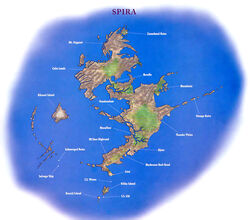
Final Fantasy X world map.
Final Fantasy X is unique in its map system. Instead of having a large World Map with towns located around it, all locations are linked through paths. The player can jump quickly from area to area once they access the airship, Fahrenheit.
Final Fantasy X-2
Template:Sideicon
In Final Fantasy X-2, the player has the freedom of traveling across Spira from the beginning of the game either by land or air, although visiting Besaid, Kilika, and Bikanel islands can only be done by the airship due to game's abandonment of ship travel. The rest of the world can be visited by foot. The party uses the airship called Celsius to travel across the skies of Spira.
Final Fantasy XI
Template:Sideicon World Maps may be accessed in Final Fantasy XI through the Region section of the Main Menu. There are three maps, each with its own purpose. The Middle Lands map displays areas participating in Conquest and the region that currently owns them, and also displays the current influence in the region and the player's current Conquest Points. It does not display regions in the Middle Lands of Vana'diel that are not participating in Conquest, such as Promyvion.
The Aradjiah map displays the areas of Besieged, and each of the various faction's current strength, the number of prisoners they have, and the number of Archaic Mirrors they possess. It also displays an adventurer's current Imperial Standing.
The Shadowreign era map displays the fronts of Campaign, as well as their current owners. It also displays the influence the current owning faction has in the region, as well as whether or not a battle is currently taking place. It also keeps track of an adventurer's Allied Notes.
Template:Gallery
Final Fantasy XII
Template:Sideicon

Ivalice in-game map.
Ivalice is the name for a region in the world of Final Fantasy XII. It has three continents: Valendia, Ordalia and Kerwon. Final Fantasy XII has no traditional overworld, similar to Final Fantasy X, but the areas are much more wide and open. The player can travel through the world on foot, teleport via a Gate Crystal, or use the party's airship.
Unlike previous games, Final Fantasy XII's world map indicates that the area explored by the player is only a small part of the entirety of Ivalice, with much of the continents stretching beyond the view of the world map.
Final Fantasy XII: Revenant Wings
Template:Sideicon
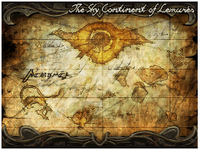
The Purvama of Lemurés.
The first chapter of Revenant Wings takes place in the same Ivalice as Final Fantasy XII. After the acquisition of the Galbana, the Purvama of Lemurés is accessible and plays host to the majority of the game's events. Later in the story, the party may freely travel between Lemurés, Ivalice, and the lofty Keep of Forgotten Time.
Unique among Final Fantasy installments, Revenant Wings allows the player to travel by airship very early in the game, and the world map itself requires a very short amount of walking.
Lightning Returns: Final Fantasy XIII
Template:Sideicon
Nova Chrysalia.
Nova Chrysalia is the world which was created in the finale of Final Fantasy XIII-2, when Caius was stabbed through his Heart of Chaos, which was Etro's own heart. This caused Valhalla to manifest, Chaos leaked into Gran Pulse and the newly arisen Bhunivelze, and created Nova Chrysalia in the process. The newly emerged then land was a vast planet, but at the time of Lightning Returns: Final Fantasy XIII most of the world was destroyed by Chaos and only four continents connected by monorail remain at the time of Lightning's awakening. The remnants of Nova Chrysalia float in a blue lagoon in the Sea of Chaos.
Final Fantasy Type-0
Template:Sideicon
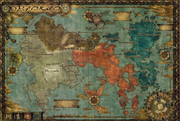
World Map in Type-0.
The player can travel the world map by chocobo. While there are monsters that roam about the map, there are also random encounters that the player can get into.
Template:Sec-stub
Final Fantasy XV
Template:Sideicon Final Fantasy XV is planned to feature an overworld as a means of traveling around its world.
Final Fantasy Tactics
Template:Sideicon
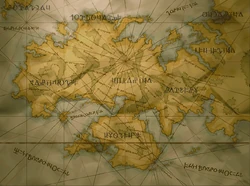
The Map of Ivalice, without the specific locations.
The world of Final Fantasy Tactics, Ivalice, differs from that of previous games. It is made up of a series of locations represented by glowing dots on a 2-D map which the player can see at all times when not in battle. Ramza can move between these dots, and each space traversed takes up one day.
Blue dots signal a peaceful town or city, green dots signal an area where a random battle has a 50% chance of occurring, and red dots signal a location where a storyline mission will be forced upon moving onto the dot.
Final Fantasy Tactics Advance
Template:Sideicon
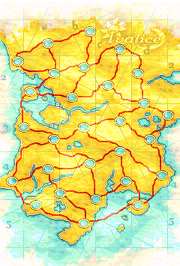
Ivalice in Final Fantasy Tactics Advance.
Final Fantasy Tactics Advance is also set in Ivalice, but its geography is different from that of Final Fantasy Tactics. The world map is again a 2-D plane made up of a total of 24 location symbols rather than the worlds of other Final Fantasies. With a few exceptions, a new area can be placed in blank circles on the World Map whenever Marche completes certain missions. Moving between spaces on the map, symbolic or blank, takes one day.
Final Fantasy Tactics A2: Grimoire of the Rift
Template:Sideicon
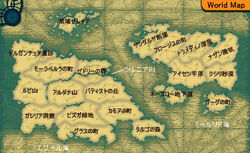
Map of Jylland.
A 2D region of Ivalice called Jylland is used for Final Fantasy Tactics A2. This Ivalician area spans two continents; Loar in the west and Ordalia in the east. s are used to travel between these two continents, from Moorabella in the west to Fluorgis in the east. Jylland is comprised of five territories, in which there are many smaller territories and locations. Tactics A2 differs from Tactics Advance in that all locations are set, and traveling between locations does not necessarily take up one day.
Template:Gallery
Final Fantasy Crystal Chronicles
Template:Sideicon
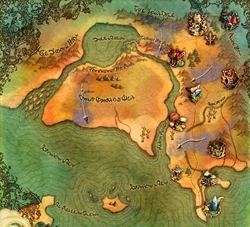
World Map in Crystal Chronicles.
Final Fantasy Crystal Chronicles's world is split into nine areas, each one containing dungeons or settlements. The dungeons and settlements are represented by little icons that represent the area. The Tipa Caravan moves across the map by selecting a location; along the way, random events can be witnessed on the path. To enter another area, the caravan must past through the Miasma Stream, which, depending upon the year in the game, can only be passed if the Crystal Chalice element matches the Miasma Stream's element for that year.
Final Fantasy Crystal Chronicles: Ring of Fates
Template:Sideicon
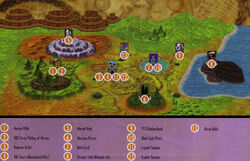
World Map in Ring of Fates.
Final Fantasy Crystal Chronicles: Ring of Fates's map is made up of one area with towns and dungeons represented by small portraits on a 3D map. The entire map can be viewed freely, but new dungeons only appear as players progress through the game.
Final Fantasy Crystal Chronicles: My Life as a King
Template:Sideicon
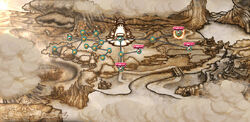
World map in My Life as a King.
Final Fantasy Crystal Chronicles: My Life as a King's map is used to assign quests for the adventures sent out by King Leo. None of the locations (besides Padarak) are seen, and they are only explored by the adventures. As they explore and defeat the bosses in each dungeon new locations show up on the map.
Final Fantasy Crystal Chronicles: Echoes of Time
Template:Sideicon
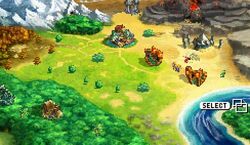
Overworld in the Echoes of Time.
In Final Fantasy Crystal Chronicles: Echoes of Time, dungeons and towns are represented by icons, much like in the original Crystal Chronicles. When connecting with friends, other icons will appear, such as character polygons or new locations. Characters are also able to freely move around on the map, much like in the old Final Fantasy games, except that there are no enemies nor monsters to fight against with.
Final Fantasy Crystal Chronicles: The Crystal Bearers
Template:Sideicon Template:Sec-stub
Final Fantasy Mystic Quest
Template:Sideicon
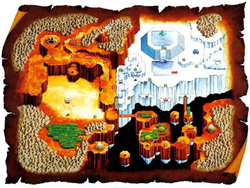
Artwork of the world map.
The player controls Benjamin on the world map. At first, the map is nearly all hidden by clouds except for the Earth Region and the strongholds of the Vile Four situated in the other regions. By defeating the Vile Four in their respected dungeons, new regions will be revealed as the clouds disperse on the world map. When a crystal is freed, that region will be restored back to normal.
Final Fantasy Adventure
Template:Sideicon
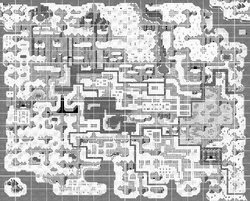
World map of Final Fantasy Adventure.
The world of Final Fantasy Adventure is one huge continent, on this continent, there's grassland, a marsh, a coastal beach, a forest, three deserts, snowfields, a mountainous region, and two small islands.
Final Fantasy Legend II
Template:Sideicon Final Fantasy Legend II has thirteen worlds the player will explore during their journey, each different from one another. Each of them are separated from one another, but they are all connected to the Celestial World by the Pillar of Sky.
Final Fantasy Legend III
Template:Sideicon Final Fantasy Legend III has two types of world maps for the original world: the Overworld and the Seafloor. But there are three different versions of the Overworld and Seafloor maps: the Past, Present, and Future version of the original world are all different from one another. There is also the Floatland map which is only accessible in the Future World. The last two maps are Pureland; the Overworld and the Underworld.
Template:Gallery
Final Fantasy: The 4 Heroes of Light
Template:Sideicon Template:See Also
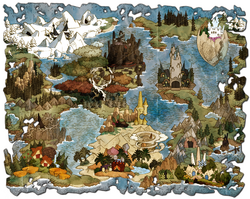
World Map of The 4 Heroes of Light.
The player controls the lead character of their party on the map, although Brandt's icon is always displayed on the map view as an indicator of the player's location, regardless of whether Brandt is actually in the party or not. The map is 3D but the player can't rotate the map like in most other games. Some locations on the world map can only be entered by transforming into an animal with the Transformation Staff.
Initially, the player has no map view while on the world map, but they are given the map of the world during the story. The map is not as detailed as in other Final Fantasy games, and is merely an artwork of the world and doesn't have the locations displayed on it, although it does show the player's current position.
Bravely Default
Template:Sideicon
Final Fantasy Dimensions
Template:Sideicon
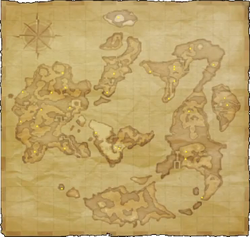
World Map of Final Fantasy Dimensions.
For the majority of the game, the world has been split into two halves, the worlds of World of Light and World of Darkness, meaning that the world map is also segmented as well. It isn't until early in Chapter 4, when the world has become whole again and changes into the World of Dusk, that the map is given to the Warriors of Light and Darkness by Dr. Lugae. It contains every location ever visited by both parties, and extra locations that weren't. All of these locations are accessible by airship by the end of the game.
Dissidia 012 Final Fantasy
Template:Sideicon
Unlike its predecessor, Dissidia 012 has a 3D World Map. It is used for most of the story; however, the classic "Game Board" returns for dungeons. Certain actions earn the player Kupo Points (KP), which can be used at the Moogle Shops located around the world map. The player is able to form parties to travel the world map with. The map shown is a very similar to the original Final Fantasy's world map, although in a post-apocalyptic atmosphere, with all cities in ruins.[1]
Final Fantasy Airborne Brigade
Template:Sideicon
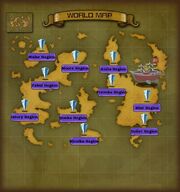
World Map of Final Fantasy Airborne Brigade.
References
Template:Locations Template:Miscellaneous

